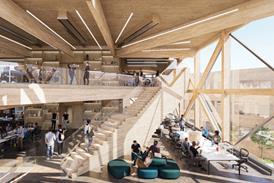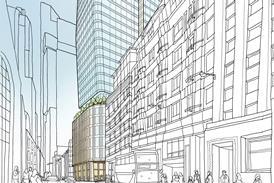Julia Park scrutinises a thoughtful new report and calls on architects to pay more attention to the long-term maintenance of housing they design

This is one of four questions that the Charted Institute of Housing (CIH) has used to stimulate debate on the future of social housing. The findings of their research were published last month in Rethinking Social Housing, a well-written report that provides plenty of food for thought.
They also asked: What is social housing? What does it do? And what should its purpose be? All pretty straightforward until you try to answer them. I fell at the first hurdle. While I support the principle of lifetime tenancies, I struggle with the reality that allowing households whose incomes have risen enough to allow them to buy or rent on the open market, to remain indefinitely, denying others with greater needs and lower incomes, that opportunity.
I’m obviously not alone: based on feedback, the report suggests three very different roles that social housing might have:
- An “ambulance service” for people with acute needs, time-limited and subject to income limits
- A “safety net” offering longer-term help for people on low incomes who can’t afford market housing
- A “wider affordability role” catering for a range of people, competing with private housing, raising standards and curbing excessive price rises.
It’s challenging stuff and well timed. Having committed to a green paper on social housing following the Grenfell fire, the government has to make time to listen and be prepared to consider radical reform of a system that is still very highly valued by the public (a key finding of the CIH report), but obviously in distress.
Shelter’s Big Conversation asked similar questions and Savills’ latest housing sector survey also focuses on social housing, noting that while it is “clearly the number one housing type required”, it is still not getting the political and financial support it needs. Recognising the “improved policy environment” for new affordable homes, it notes that access to land and insufficient funding are still major barriers for housing associations which are under increasing pressure to build housing of all tenures. Having to be business-savvy while operating on a not-for-profit basis is bound to cause tensions and Savills identifies a mismatch between the priorities of individuals and those of their organisations.
The CIH, Shelter and Savills all question the terminology, labels and ever-growing range of tenure types that are at best confusing and at worst disabling – particularly when trying to access funding, but even when simply trying to have a sensible conversation. To me, social housing isn’t a type of housing at all, it’s simply a type of tenure; a form of affordable rent that makes housing accessible to people who would otherwise be homeless. One of the six CIH recommendations is to move towards a policy framework that links rents to local income. Sooner or later, the government must accede to this because nothing else makes sense.
The few images in the report show remarkably ordinary, low-density suburban housing – it could be spec-built volume housebuilder stuff – not the worst, but nowhere near the best. I’m sure that was deliberate and, in many ways, sensible. It’s good to remind people that social housing and tower blocks are not synonymous and that, in principle, social housing is like housing for other tenures. Fifty years on, architects are still expected to atone for the sins committed by their peers in the 60s and 70s when social housing was built on a huge scale; much of it unlike any housing people had seen before. The scapegoating of architects was largely unjustified then and is certainly unjustified now, but the lines between innovation and experimentation, and ambition and self-indulgence, can be fine.
Poor maintenance and management were partly to blame and they remain significant problems. Faced with impossibly low budgets and impossibly high housing targets, it’s easy to see how councils feel compelled to prioritise the building of new homes over upgrading existing stock. Here, at least, is a practical way in which architects can make a difference: we must consider the long-term implications of managing and maintaining the housing we design more carefully, and imagine it not just in 30 years’ time, but in 200.
We also need to make our designs flexible and tenure neutral as far possible. We know that the tenure of a home often changes and that new tenures are invented all the time. The benefits of finely grained, mixed communities are now widely appreciated. Can we be confident that the huge, new Build to Rent schemes with their institutional, double-banked apartments and no private open space could work for families? History tells us that they may not, and that it’s not good enough to say, “That’s not who they are for”.
It isn’t only here that social housing is being debated. Much of Europe is preoccupied with how to house the least well-off, and social housing is a theme of this year’s Venice Biennale; the brutal demolition of Robins Hood Gardens is contrasted with the sensitive retrofitting of tower blocks in Paris. Globally, all fast-growing cities face similar challenges, and it is cities that seem to experience the greatest extremes of rich and poor; most evident through stark contrasts in living standards.
The Spirit Level, a book by Richard Wilkinson and Kate Pickett, explains why inequality within a society is more damaging than inequality between societies. Compared with many parts of the world, London’s worst housing is luxurious. Of course that’s something that should concern us all but Wilkinson and Pickett point out that we tend to judge ourselves, and be judged, by those around us. In any given neighbourhood, those who live in the poorest-quality homes are bound to feel the least valued. That has often been the tenants of social housing but increasingly it’s the tenants of private landlords who are filling the gap left by the public sector.
The CIH report notes that “stigma” was frequently mentioned during the focus group sessions and in the written responses. There is still a perception that social housing tenants are large, “non-working” families. In fact, 43% are working (only 8% are registered unemployed) and 28% are retired. Over 40% of households are single people, and almost 50% of households report that at least one family member has a long-term illness or disability.
Addressing those four apparently innocuous questions means thinking about the kind of society we are, and the kind of society we want to be. That’s a lot to think about.
Postscript
Julia Park is head of housing research at Levitt Bernstein
















4 Readers' comments